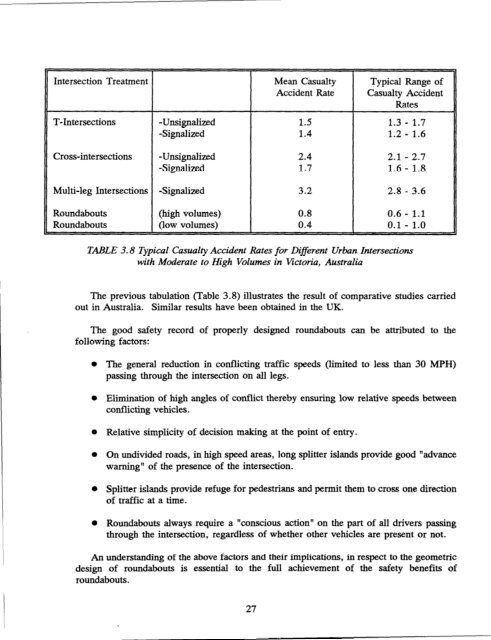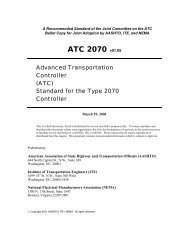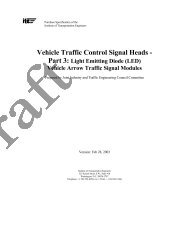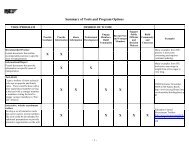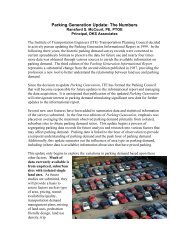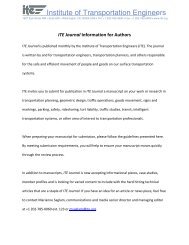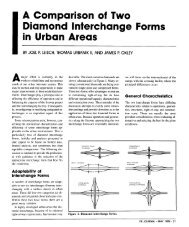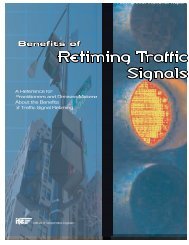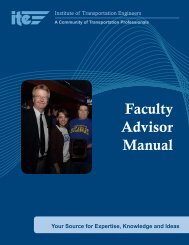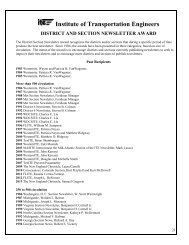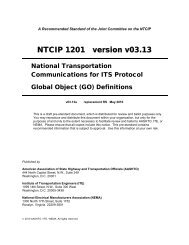roundabout ~' ~ design guidelines - Institute of Transportation ...
roundabout ~' ~ design guidelines - Institute of Transportation ...
roundabout ~' ~ design guidelines - Institute of Transportation ...
Create successful ePaper yourself
Turn your PDF publications into a flip-book with our unique Google optimized e-Paper software.
Intersection Treatment<br />
Mean Casualty<br />
Accident Rate<br />
Typical Range <strong>of</strong><br />
Casualty Accident<br />
Rates<br />
T-Intersections -Unsignalized 1.5 1.3 - 1.7<br />
-Signalized 1.4 1.2 - 1.6<br />
Cross-intersections -Unsignalized 2.4 2.1 - 2.7<br />
-Signalized 1.7 1.6 - 1.8<br />
Multi-leg Intersections -Signalized 3.2 2.8 - 3.6<br />
Roundabouts (high volumes) 0.8 0.6 - 1.1<br />
Roundabouts (low volumes) 0.4 0.1 - 1.0<br />
TABLE 3.8 Typical Casualty Accident Rates for Diflerent Urban Intersections<br />
with Moderate to High Volumes in Victoria, Australia<br />
The previous tabulation (Table 3.8) illustrates the result <strong>of</strong> comparative studies carried<br />
out in Australia. Similar results have been obtained in the UK.<br />
The good safety record <strong>of</strong> properly <strong>design</strong>ed <strong>roundabout</strong>s can be attributed to the<br />
following factors:<br />
The general reduction in conflicting traffic speeds (limited to less than 30 MPH)<br />
passing through the intersection on all legs.<br />
Elimination<br />
conflicting<br />
<strong>of</strong> high angles <strong>of</strong> conflict thereby ensuring low relative speeds between<br />
vehicles.<br />
Relative simplicity<br />
<strong>of</strong> decision making at the point <strong>of</strong> entry.<br />
On undivided roads, in high speed areas, long splitter islands provide good “advance<br />
warning” <strong>of</strong> the presence <strong>of</strong> the intersection.<br />
Splitter islands provide refuge for pedestrians and permit them to cross one direction<br />
<strong>of</strong> traffic at a time.<br />
Roundabouts always require a “conscious action” on the part <strong>of</strong> all drivers passing<br />
through the intersection, regardless <strong>of</strong> whether other vehicles are present or not.<br />
An understanding <strong>of</strong> the above factors and their implications, in respect to the geometric<br />
<strong>design</strong> <strong>of</strong> <strong>roundabout</strong>s is essential to the full achievement <strong>of</strong> the safety benefits <strong>of</strong><br />
<strong>roundabout</strong>s.<br />
27


